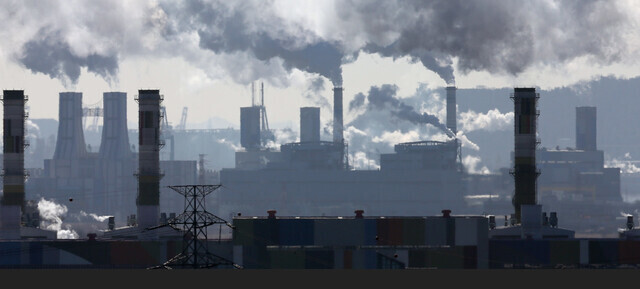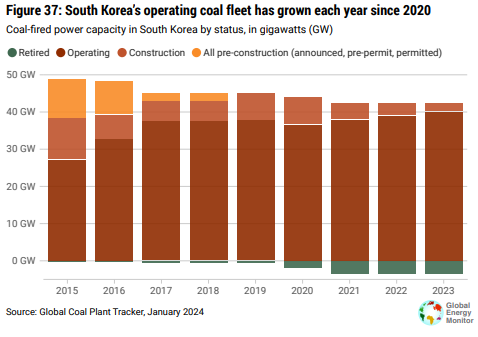hankyoreh
Links to other country sites 다른 나라 사이트 링크
Korea ranks among 10 countries going backward on coal power, report shows

Global coal-fired power generation increased by about 2% last year, according to a new report. That’s because more new coal power plants are being brought online than are being closed down. China is the country with the largest number of new coal plants, but Korea’s coal-fired generation capacity has also continued to increase since 2021.
According to a new report titled “Boom and Bust Coal 2024,” coal-fired capacity around the world last year stood at 2,130 GW (gigawatts). That was 48.4 GW more than the previous year, which was the result of just 21.1 GW of existing capacity being shuttered even as 69.5 GW of new capacity was brought online.
The “Boom and Bust Coal” report on global trends in coal-fired power generation is published annually by Global Energy Monitor along with various environmental partners including Sierra Club and Korea-based nonprofit Solutions for Our Climate.
Two-thirds of the new capacity, amounting to 47.4 GW, consisted of newly commissioned coal plants in China. The report listed China as being one of 10 countries that are bucking the global trend by increasing coal power capacity. The others are Bangladesh, Greece, India, Indonesia, Japan, Pakistan, South Korea, Vietnam and Zimbabwe. Notably, Korea’s coal-fired capacity had decreased until 2021 but has been on the rise since then, reaching 40.1 GW last year.
In 2021, President Moon Jae-in officially adopted a plan to phase coal out of Korea’s energy mix by 2050. But the report noted that Korea has yet to prepare a concrete phaseout plan and is not on course to meet its nationally determined contributions (NDCs) for reducing greenhouse gas emissions under the Paris Agreement.

Under its NDCs, Korea is supposed to bring emissions down to 40% of its 2018 level (727.6 million tons) by 2030. But Korea’s 10th Basic Plan for Electricity Supply and Demand (2022–2036) assumes that 41 coal plants with a total capacity of 31.7 GW will be in operation in 2030. That’s only a 21% (8.4 GW) decrease from the current level of 40.1 GW.
In addition, two units began operation over the past two years at the Gangneung Anin coal plant and two more units will be activated at the Samcheok Blue Power plant this month.
According to the report, China began construction last year on new coal plants with a combined capacity of 70.2 GW, which was 19 times the capacity (3.6 GW) of new plants going up in the rest of the world.
“China’s recent huge increase in coal-fired power generation stands in stark contrast to global trends and puts China’s climate goals at risk. It’s important for China to tighten regulations on coal-fired generation projects and speed up the transition to renewable energy,” said Qi Qin, a China analyst for the Centre for Research on Energy and Clean Air.
By Park Ki-yong, staff reporter
Please direct questions or comments to [english@hani.co.kr]

Editorial・opinion
![[Column] Season 2 of special prosecutor probe may be coming to Korea soon [Column] Season 2 of special prosecutor probe may be coming to Korea soon](https://flexible.img.hani.co.kr/flexible/normal/500/300/imgdb/original/2024/0426/3317141030699447.jpg) [Column] Season 2 of special prosecutor probe may be coming to Korea soon
[Column] Season 2 of special prosecutor probe may be coming to Korea soon![[Column] Park Geun-hye déjà vu in Yoon Suk-yeol [Column] Park Geun-hye déjà vu in Yoon Suk-yeol](https://flexible.img.hani.co.kr/flexible/normal/500/300/imgdb/original/2024/0424/651713945113788.jpg) [Column] Park Geun-hye déjà vu in Yoon Suk-yeol
[Column] Park Geun-hye déjà vu in Yoon Suk-yeol- [Editorial] New weight of N. Korea’s nuclear threats makes dialogue all the more urgent
- [Guest essay] The real reason Korea’s new right wants to dub Rhee a founding father
- [Column] ‘Choson’: Is it time we start referring to N. Korea in its own terms?
- [Editorial] Japan’s rewriting of history with Korea has gone too far
- [Column] The president’s questionable capacity for dialogue
- [Column] Are chaebol firms just pizza pies for families to divvy up as they please?
- [Column] Has Korea, too, crossed the Rubicon on China?
- [Correspondent’s column] In Japan’s alliance with US, echoes of its past alliances with UK
Most viewed articles
- 1‘We must say no’: Seoul defense chief on Korean, USFK involvement in hypothetical Taiwan crisis
- 2Why Kim Jong-un is scrapping the term ‘Day of the Sun’ and toning down fanfare for predecessors
- 3After election rout, Yoon’s left with 3 choices for dealing with the opposition
- 4Two factors that’ll decide if Korea’s economy keeps on its upward trend
- 5BTS says it wants to continue to “speak out against anti-Asian hate”
- 6Gangnam murderer says he killed “because women have always ignored me”
- 7South Korea officially an aged society just 17 years after becoming aging society
- 8[Column] Park Geun-hye déjà vu in Yoon Suk-yeol
- 9Division commander ordered troops to enter raging flood waters before Marine died, survivor says
- 10No good, very bad game for Korea puts it out of Olympics for first time since 1988